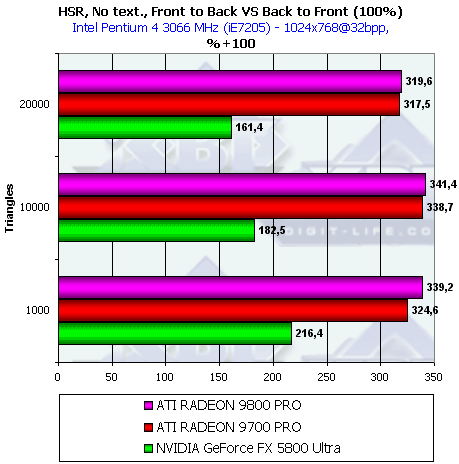 |
||
|
||
| ||
RightMark 3D synthetic test results (DirectX 9), 2D graphicsEven Nero, the Roman emperor, who liked to draw very much, was familiar with 2D graphics. At those far times everyone in his circle, even his mother, knew that 2D quality depended on quality of paints (now it depends on a monitor), on brushes (now it depends on a video card), and on artist's view. But that philosophy drove him mad as he considered 2D an ideal to be worshiped, and he even killed his mother... But Nero's spirit hasn't calmed down yet and it often appears like a horror in front of those who got blurry images... Only if you have reliable shielded cables and hgih-quality monitors Nero's spirit will never find his shelter there... That is why we 2D tests were carried out with ViewSonic P817-E monitor and Bargo BNC cable. RADEON 9800 PRO has perfect 2D quality! It perfectly works at 1600x1200@85Hz and 1280x1024@120Hz. But remember that quality depends also on a certain sample. Today we will describe and run the suite of synthetic tests we are currently developing for the DX9 API. The developed RightMark3D test suite now includes the following synthetic tests:
The philosophy of these synthetic tests and their description are given in NV30 Review. Those who are eager to try RightMark 3D synthetic tests can download the "command-line" test versions which record the final XLS file in the XML format accepted in Microsoft Office XP: Every archive contains description of test parameters and an example of a BAT file used for benchmarking accelerators. We welcome your comments and ideas as well as information on errors or improper behavior of the tests. Below is the data obtained with budget and mainstream accelerators based on two major families (ATI and NVIDIA).
Pixel FillingAs the latest Catalyst drivers (3.1 and higher) show rather dubious results in our synthetic test on some ATI's cards (probably because of the failed attempt to optimize this test in the modes with texture sampling), the results of Pixel Filling with textures for RADEON won't be published, only the case without textures.  It's obvious that here the difference in the scores is based on the different clock speeds of RADEON 9700 and RADEON 9800. ATI's chips keep ahead in the modes with shading enabled due to 8 pixel pipelines (against 4 of NV30) and sufficient bandwidth of the 256-bit memory bus.
NVIDIA is closer to its theoretical peak though ATI is not far either; only RADEON 9700 PRO could have it better if it were not for the limiting memory bandwidth. Geometry Processing SpeedFixed TCL performance (performance of the shader that emulates it):  In case of the fixed TCL the performance gap corresponds to the difference in the frequencies. Vertex Shaders 1.1:  It's the same with Vertex Shaders 1.1. Shaders 2.0 with loops:  Well, ATI has optimized performance of the second shaders and, in particular, loops; the performance gain is sometimes double! I think it depends on the drivers rather than on the hardware section, and I hope RADEON 9700 will also get such boost with the future drivers. But now these optimizations are included only into R350 to demonstrate, as I think, the advantages of R350 over R300 for those who do not go into details. But it is also possible that low performance of the second shaders was caused by the hardware and it could already be corrected; soon we will find out it. So, with the new drivers R350 looks better in this test than NV30. The second shaders are now as efficient as the first ones, and we can say that loops are granted for free. The driver optimization is well noticeable (in particular, for the compiler and shader microcode optimizer) -- almost double growth. I wonder if NVIDIA is going to surprise us soon like it often happened before? Let's check the cross dependence on geometry detail level and shader's complexity:   The performance balance remains the same irregardless of scene complexity - it seems that the size and algorithms of vertex queues and caches were not changed. Hidden Surface RemovalHSR efficiency in different resolutions in a complex scene (without and with textures):   the slight difference is caused by the side effects -- the difference is the frequencies. Any change of the HSR algorithm or its efficiency would make the scores more different. HSR efficiency depending on scene complexity (without and with textures):   The single-level HSR of NVIDIA prefers simple scenes while ATI's hierarchical algorithm performs best of all in average scenes, but textures bring closer these approaches regarding the behavior and effectiveness. Ideally, NVIDIA's HSR is less efficient but in reality textures and early Z culling make this difference inconsiderable. Pixel ShadingHave a look at the performance of pixel shader s in R350 in comparison with R300:  As expected, the performance growth of R350 with the second pixel shaders agrees well with the increased core frequency. As a result, the defeat of NVIDIA's NV30 looks even sadder. Point SpritesLighting off/on:   The gap is a bit greater than the difference in the clock speeds because of the optimized second vertex shaders. Now, in contrast to R300, NV30 fails in all modes. Write a comment below. No registration needed!
|
|
Platform · Video · Multimedia · Mobile · Other || About us & Privacy policy · Twitter · Facebook
Copyright © Byrds Research & Publishing, Ltd., 1997–2011. All rights reserved.